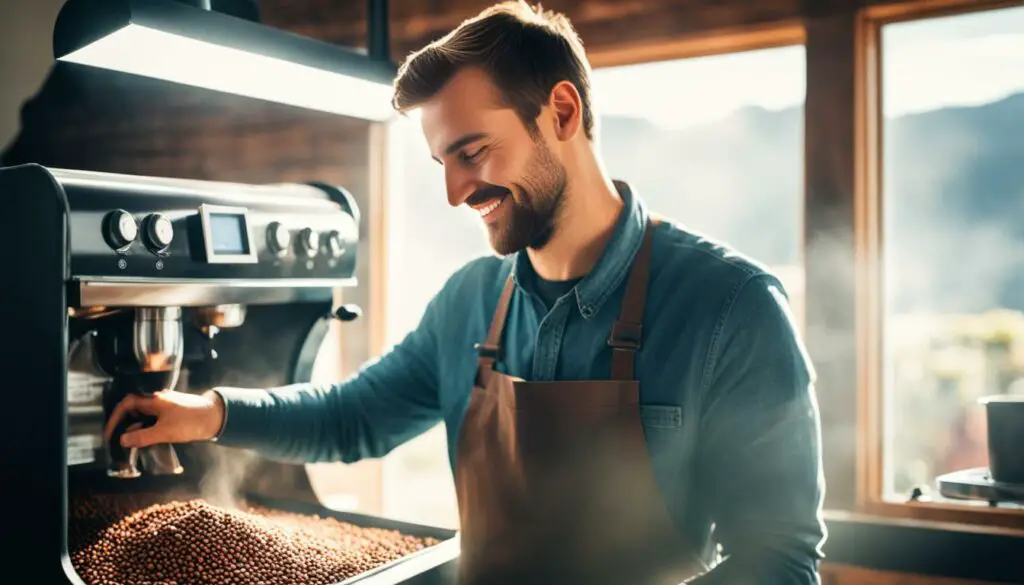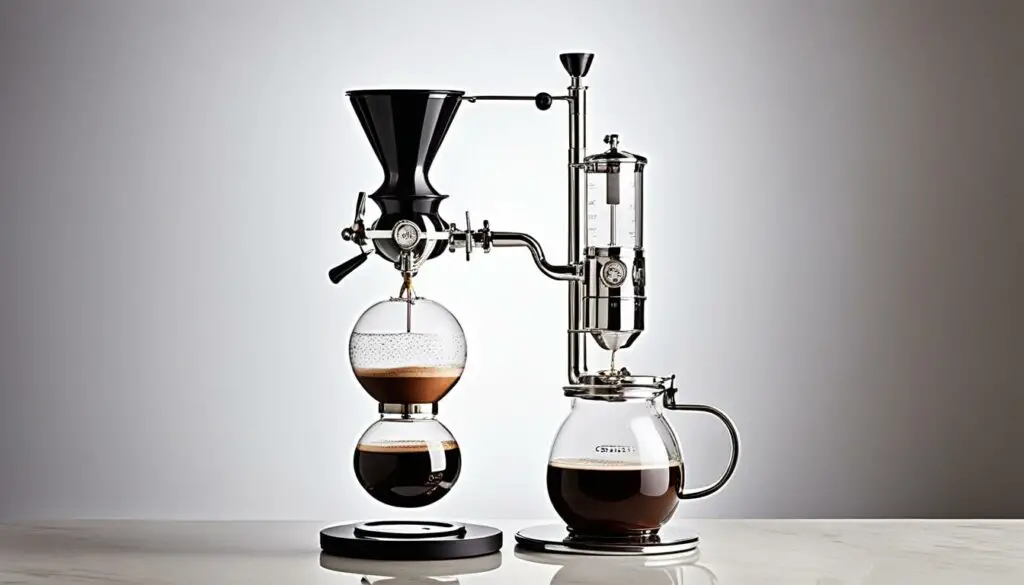Making espresso coffee at home has never been easier. You don’t need expensive equipment or barista skills to enjoy a delicious cup of homemade espresso. In this article, we will explore various methods and techniques that will help you craft the perfect espresso-like coffee right in the comfort of your own kitchen.

Key Takeaways:
- Learn how to make espresso coffee at home without expensive equipment.
- Discover alternative methods to brew a perfect cup of espresso-like coffee.
- Understand the science behind espresso brewing and the characteristics of good espresso beans.
- Master the art of using an espresso machine or explore methods without a machine.
- Get helpful tips and tricks for brewing the perfect espresso in your own kitchen.
The AeroPress Method for Making Espresso
If you’re looking for a simple and affordable way to make espresso-like coffee at home, the AeroPress method is a great option. This portable brewing device uses a combination of pressure and immersion to extract bold and flavorful coffee. With a few easy steps, you can enjoy a delicious cup of homemade espresso.
To get started, you’ll need an AeroPress, coffee grounds, hot water, and a filter. Begin by placing a filter inside the AeroPress cap and rinsing it with hot water. This helps remove any paper flavors and preheats the brewer. Next, measure out the desired amount of coffee grounds and add them to the AeroPress chamber.
Pour hot water over the coffee grounds, saturating them completely. Stir the mixture gently to ensure all the grounds are evenly soaked. After a brief steeping time, insert the plunger into the AeroPress and press down slowly and steadily. The pressure created by pressing the plunger forces the brewed coffee through the filter and into your cup below.
“The AeroPress method allows you to control various brewing parameters, such as water temperature, grind size, and brew time, giving you the flexibility to experiment and fine-tune your espresso recipe to your liking.”
Pros and Cons of the AeroPress Method
The AeroPress method offers several advantages for homemade espresso enthusiasts. It’s inexpensive, portable, and easy to clean, making it perfect for traveling or use in small spaces. The quick brewing time and simple operation also make it ideal for beginners.
However, it’s important to note that while the AeroPress produces a concentrated coffee that resembles espresso, it’s not a traditional espresso machine. The coffee brewed with the AeroPress may lack some of the trademark characteristics of true espresso, such as a thick crema. Nevertheless, the AeroPress method still delivers a strong and flavorful cup of coffee that can be enjoyed on its own or used as a base for various espresso-based drinks.
| Pros | Cons |
|---|---|
| Easy to use and clean | Doesn’t produce a traditional espresso crema |
| Portable and lightweight | May not satisfy strict espresso purists |
| Affordable option | Requires manual pressure |
| Versatile brewing parameters |
With the AeroPress method, you can enjoy a homemade espresso-like coffee without the need for an expensive machine. Experiment with different grind sizes, water temperatures, and brew times to find your perfect recipe. Whether you’re a coffee enthusiast or a beginner, the AeroPress offers a convenient and cost-effective way to indulge in a delicious cup of espresso at home.
The Moka Pot Method for Making Espresso
The Moka pot is a classic and reliable brewing method that allows you to create a rich and satisfying espresso-like coffee right in your own kitchen. It’s an affordable alternative to expensive espresso machines and can produce a bold and flavorful cup of espresso with minimal effort. To make espresso using the Moka pot method, follow these simple steps:
- Fill the bottom chamber of the Moka pot with water up to the fill line. Make sure not to exceed the maximum capacity.
- Grind your coffee beans to a medium-fine consistency. It’s important to use freshly ground beans for the best flavor.
- Insert the coffee grounds into the filter basket and level it off with a slight tamp. Avoid compacting the grounds too much, as it can restrict the flow of water.
- Screw the top chamber onto the bottom chamber, ensuring a tight seal. Place the Moka pot on a stovetop burner set to medium heat.
- As the water heats up, it will create pressure that pushes the hot water through the coffee grounds and into the top chamber. You’ll hear a gurgling sound, indicating that the brewing process is complete.
- Remove the Moka pot from the heat and let it sit for a minute to allow the coffee to settle. Then, pour your freshly brewed espresso into your favorite cup.
The Moka pot method offers a unique brewing experience that combines the convenience of stovetop brewing with the bold flavors of espresso. It’s important to note that while the Moka pot produces a strong concentrate similar to espresso, it’s not able to generate the same level of pressure as a traditional espresso machine. As a result, the coffee produced by the Moka pot may have a slightly different taste and texture compared to a true espresso shot, but it still provides a delicious and satisfying coffee experience.
Experiment with different coffee bean varieties, grind sizes, and brewing techniques to find the perfect balance of flavors that suits your taste preferences. With the Moka pot method, you can enjoy the art of homemade espresso brewing and indulge in the rich aromas and flavors of a freshly brewed cup of coffee.
Comparison: Moka Pot vs. Espresso Machine
| Method | Moka Pot | Espresso Machine |
|---|---|---|
| Cost | Relatively inexpensive | Expensive |
| Pressure | Lower pressure | Higher pressure |
| Flavor | Rich and bold, with slight variations | Intense and concentrated |
| Convenience | Requires stovetop and manual operation | Automated process |
The table provides a comparison between the Moka pot method and an espresso machine. While the Moka pot offers an affordable and convenient option for home brewing, it’s important to note that it may not produce the same results as a dedicated espresso machine. The choice between the two methods ultimately depends on your preferences, budget, and desired level of convenience.
The French Press Method for Making Espresso
If you’re looking for a simple and accessible way to make espresso at home, the French press method is a fantastic option. While it may not be the traditional method for making espresso, the French press can still produce a rich and concentrated coffee shot that satisfies your cravings. Plus, you don’t need any expensive equipment or specialized knowledge to get started. With just a few simple steps, you can enjoy a delicious homemade espresso-like coffee.
Step-by-Step Instructions
- Start by grinding your coffee beans to a coarse consistency. For a French press, a medium grind works best.
- Measure out the desired amount of coffee grounds based on the strength you prefer. A general rule of thumb is to use a ratio of 1:15, meaning 1 gram of coffee for every 15 grams of water.
- Boil water and let it cool slightly for about 30 seconds to 1 minute. The ideal temperature for brewing coffee in a French press is around 195°F (90°C).
- Add the coffee grounds to the French press, followed by the hot water.
- Give the mixture a gentle stir to ensure all the grounds are saturated, then place the lid on top with the plunger in the up position.
- Let the coffee steep for about 4 minutes.
- After the steeping time has passed, slowly press down the plunger to separate the coffee grounds from the liquid.
- Pour the freshly brewed espresso-like coffee into your favorite cup and enjoy!
The French press method allows you to have full control over the brewing process, allowing you to adjust the strength and flavor of your espresso-like coffee to your preferences. The longer the steeping time, the stronger the coffee will be, while a shorter steeping time will result in a milder brew. Experiment with different ratios, grind sizes, and steeping times to find the perfect balance that suits your taste.
With its simplicity and versatility, the French press method is an excellent option for those who want to make espresso coffee from scratch without investing in expensive machines. So, why not give it a try? Brew a delicious cup of espresso-like coffee using the French press and savor the rich and bold flavors right in the comfort of your own home.
The Science Behind Espresso
Understanding the science behind brewing espresso can help you achieve a delicious and consistent cup every time. There are several key factors that contribute to the unique characteristics of espresso coffee. In this section, we will explore the pressure required for brewing espresso, the importance of grind size, and delve into the origins and history of this beloved coffee beverage.
The Pressure Factor:
One of the defining features of espresso is its strong and concentrated flavor. This intensity is achieved through the use of high pressure during the brewing process. Espresso machines are designed to exert around 9 bars (~130 pounds per square inch) of pressure on the coffee grounds. This pressure forces hot water through the finely ground coffee, extracting more flavor compounds and oils than other brewing methods.
The Grind Size Matters:
In addition to pressure, the size of the coffee grounds plays a crucial role in the extraction process. For espresso, a fine grind is essential. The small particle size allows for optimal surface area contact with water, ensuring thorough extraction and producing a rich and creamy espresso shot. Experimenting with different grind sizes can help you find the perfect balance between flavor strength and extraction time.
The Origins of Espresso:
The history of espresso dates back to the late 19th century in Italy. The invention of the espresso machine revolutionized the way coffee was prepared and consumed. The first modern espresso machine, patented by Luigi Bezzera in 1901, used steam pressure to force water through coffee grounds. Over time, the technology evolved, leading to the development of more advanced machines capable of delivering consistent and high-quality espresso.
“Espresso is a miracle of chemistry in a cup.”
– Author Unknown
The creation of espresso represents the culmination of scientific understanding, engineering innovation, and a deep appreciation for the art of coffee making. Understanding the principles behind espresso brewing can help you develop your own techniques and explore the endless possibilities of homemade espresso coffee.
Tips for Making Espresso at Home – Best Practices for Homemade Espresso
Making espresso at home can be a rewarding experience, but it requires attention to detail and the right techniques. To ensure you achieve the best results, here are some valuable tips and best practices for brewing the perfect cup of homemade espresso.
Choosing the Right Beans
The foundation of a good espresso starts with selecting the right beans. Look for beans that are specifically labeled for espresso. These beans are typically roasted to a darker level, which brings out the flavors and creates a rich, bold taste. Additionally, opt for whole beans and grind them just before brewing to preserve the freshness and aroma.
Getting the Grind Size Right
The grind size plays a crucial role in the extraction process. For espresso, you’ll want to aim for a fine grind that resembles powdered sugar. This allows for maximum surface area contact with the water, resulting in a balanced and flavorful extraction. Experiment with different grind sizes to find the perfect consistency for your taste preferences.
Mastering the Extraction Time
When brewing espresso, the extraction time is essential for achieving the desired strength and flavor. Aim for an extraction time of around 25 to 30 seconds. This timeframe allows for the optimal extraction of flavors without over-extracting, which can result in bitterness. Use a timer to consistently track the extraction time and adjust your technique accordingly.
| Tip | Explanation |
|---|---|
| Preheat Your Equipment | Before brewing, make sure to preheat your espresso machine or brewing equipment. This step helps maintain a stable brewing temperature and ensures optimal extraction. |
| Pack the Grounds Properly | When using a portafilter or espresso machine, ensure that the grounds are evenly distributed and packed firmly. This promotes even extraction and prevents channeling. |
| Experiment with Water Temperature | The ideal water temperature for brewing espresso is between 195°F and 205°F (90°C and 96°C). However, taste preferences can vary, so don’t be afraid to experiment with different water temperatures to find the one that suits your palate. |
By following these tips and best practices, you’ll be well on your way to brewing delicious and satisfying espresso right in the comfort of your own home. Remember, practice makes perfect, so don’t be discouraged if your first few attempts aren’t flawless. With time and experience, you’ll become a master of homemade espresso.
How to Make Espresso Using an Espresso Machine
If you have an espresso machine at home, you’re in luck! Making espresso becomes even easier with this specialized equipment. Follow these step-by-step instructions to brew a perfect cup of homemade espresso.
Step 1: Prepare the Machine
Before you begin, ensure that your espresso machine is clean and filled with fresh water. Check that the water reservoir is full and the portafilter and filter basket are clean. This will ensure optimal brewing conditions and a clean, flavorful cup of espresso.
Step 2: Grind Your Coffee
For espresso brewing, it’s crucial to use a fine grind size. Grind your coffee beans just before brewing to preserve the flavors and aromas. Aim for a consistency similar to table salt. Measure the appropriate amount of coffee grounds for your desired strength.
Step 3: Tamp the Coffee
After grinding, transfer the coffee grounds to the portafilter. Use a tamper to firmly press the grounds down in the filter basket. Apply even pressure to create a level surface. This step is essential for a proper extraction and extraction.
Step 4: Brew and Extract
Place the portafilter back into the espresso machine and start the brewing process. The water should pass through the coffee grounds under high pressure, producing a concentrated shot of espresso. The extraction time will vary depending on your machine, but it typically takes around 20 to 30 seconds.
Step 5: Enjoy Your Espresso
Once the extraction is complete, you can pour your freshly brewed espresso into a pre-heated cup. Take a moment to appreciate the rich aroma and beautiful crema on top. Savor each sip and enjoy the satisfaction of a homemade espresso.

Mastering the art of making espresso with an espresso machine may take some practice, but with time and experimentation, you’ll be able to create barista-quality coffee in the comfort of your own home. Don’t forget to clean and maintain your espresso machine regularly to ensure optimal performance and longevity. Now, go ahead and indulge in the wonderful world of homemade espresso coffee!
Making Espresso Without a Machine
If you don’t have an espresso machine at home, don’t worry! There are alternative methods you can use to make espresso-like coffee right in your kitchen. While these methods may not produce the exact same result as a traditional espresso machine, they can still deliver a rich and satisfying cup of homemade espresso.
The Stovetop Espresso Method: One popular method is using a stovetop espresso maker, also known as a Moka pot. This Italian invention consists of a bottom chamber for water, a middle chamber for ground coffee, and a top chamber for the finished espresso. Simply fill the bottom chamber with water, add finely ground coffee to the middle chamber, assemble the pot, and place it on the stove. As the water heats up, it creates pressure that forces the hot water through the ground coffee, resulting in a concentrated and flavorful espresso-like coffee.
The French Press Method: Another option is to use a French press. While it may not produce the same level of pressure as an espresso machine, a French press can still create a strong and concentrated coffee shot. Start by adding coarse ground coffee to the bottom of the French press, pour hot water over the coffee, and let it steep for a few minutes. Then, slowly press down the plunger to separate the grounds from the liquid, leaving you with a rich and bold espresso-like coffee.
Comparing Stovetop Espresso and French Press Methods
| Method | Pressure | Grind Size | Resulting Coffee |
|---|---|---|---|
| Stovetop Espresso | High pressure | Finely ground | Concentrated and flavorful |
| French Press | Low pressure | Coarse ground | Strong and bold |
While both methods can produce a delicious cup of homemade espresso, they offer slightly different flavors and intensities. The stovetop espresso method excels in creating a concentrated and flavorful espresso, while the French press method delivers a strong and bold coffee shot. Experiment with both to find your preferred taste profile.
Tips and Tricks for Brewing the Perfect Espresso
Mastering the art of brewing espresso at home is a rewarding experience that allows you to enjoy a delicious cup of coffee anytime you want. To help you achieve coffeehouse-quality results, here are some essential tips and tricks:
1. Start with Freshly Roasted Beans
The key to a flavorful espresso lies in the quality of the beans. Choose freshly roasted coffee beans that are specifically labeled for espresso. Look for beans with a dark roast profile, as they tend to have rich flavors and a robust body. Grinding the beans just before brewing will further enhance the aroma and taste.
2. Get the Grind Size Right
The grind size plays a crucial role in espresso extraction. For an espresso machine, aim for a fine grind similar to table salt. If you’re using alternative brewing methods, such as the AeroPress or Moka pot, adjust the grind size accordingly. Finer grind extracts more flavors, while coarser grind produces a lighter-bodied espresso. Experiment and fine-tune the grind size to achieve your preferred balance of strength and flavor.
3. Perfect Your Tamping Technique
When using an espresso machine, proper tamping ensures even extraction and prevents channeling. Apply firm and even pressure while tamping the coffee grounds into the portafilter. Aim for a level surface, avoiding uneven or lopsided tamping. This will promote consistent water flow through the coffee bed, resulting in a well-balanced espresso shot.
4. Control Water Temperature and Extraction Time
Water temperature and extraction time are critical factors in brewing espresso. Aim for a water temperature between 195°F and 205°F (90°C and 96°C) for optimal extraction. Additionally, pay attention to the extraction time, which typically ranges from 25 to 30 seconds. Adjust these variables to achieve your desired balance of flavors and strength.
| Tip | Best Practice |
|---|---|
| Invest in a quality espresso grinder | A consistent grind size is crucial for a great espresso shot |
| Preheat your espresso machine | Ensure the machine is heated to the optimal temperature before brewing |
Remember, brewing the perfect espresso is a matter of experimentation and refinement. Adjusting variables such as grind size, water temperature, and extraction time will help you fine-tune your brewing technique and achieve the ideal balance of flavors. With practice and attention to detail, you’ll be able to consistently brew a cup of espresso that rivals your favorite coffee shop’s offerings.

Conclusion
With the right equipment and knowledge, you can easily create delicious homemade espresso coffee. Experimenting with different methods and techniques will allow you to find the perfect brew that suits your taste preferences. So, become your own barista and indulge in a satisfying cup of espresso from the comfort of your home.
Whether you choose the AeroPress, Moka pot, French press, or an espresso machine, each method has its own unique way of brewing espresso-like coffee. By following the step-by-step guides provided in this article, you can confidently prepare a strong and flavorful cup of homemade espresso.
Understanding the science behind espresso, such as the required pressure and grind size, will help you achieve the perfect extraction. Additionally, selecting the right espresso beans with the ideal roast levels and grind consistency can enhance the overall flavor profile of your coffee.
Remember to utilize the helpful tips and tricks shared in this guide to fine-tune your brewing skills. From adjusting grind size to water temperature and extraction time, these techniques will elevate your espresso-making abilities and ensure a consistently great cup of coffee. So, embrace the joy of homemade espresso and enjoy the rich, aromatic experience it brings!
FAQ
Can I make espresso at home without an expensive espresso machine?
Yes, there are multiple methods for making espresso-like coffee at home without specialized equipment.
What is the AeroPress and how can I use it to make espresso?
The AeroPress is a popular device that can be used to brew a strong and flavorful cup of espresso-like coffee. Follow the provided steps to use the AeroPress effectively.
How can I make espresso using a Moka pot?
The Moka pot is another great option for brewing espresso at home. Learn the process and techniques for using a Moka pot to create a rich and satisfying espresso-like coffee.
Can I make espresso with a French press?
While not the traditional method for making espresso, the French press can still produce a concentrated and flavorful coffee shot. Discover how to use a French press to make espresso at home.
What are the basics of espresso brewing?
Understand the key factors in espresso brewing, including the required pressure and the importance of grind size. Explore the history and origins of espresso as well.
What characteristics should I look for in coffee beans for making espresso?
Discover the ideal characteristics of coffee beans for making espresso, including roast levels and grind consistency.
How can I make espresso using an espresso machine?
If you have an espresso machine, follow this guide to get the most out of your equipment. Learn the step-by-step process for making espresso using an espresso machine.
What methods can I use to make espresso-like coffee at home without specialized equipment?
Don’t have an espresso machine? No problem. Explore alternative methods to make espresso-like coffee at home without the need for expensive equipment.
What tips and tricks can help me brew the perfect espresso at home?
Master the art of brewing espresso at home with these helpful tips and tricks. Discover techniques for adjusting grind size, water temperature, and extraction time.
Can anyone make delicious espresso coffee at home?
With the right equipment and knowledge, anyone can make delicious espresso coffee at home. Experiment with different methods and techniques to find the perfect brew for your taste preferences.













